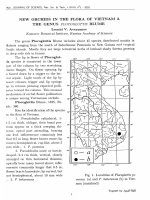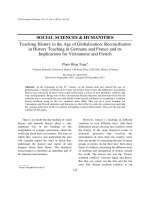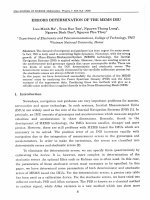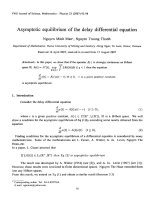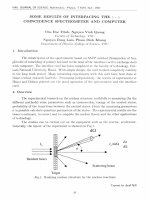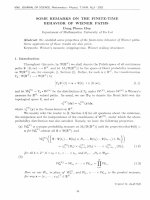DSpace at VNU: Chemical composition of the resin essential oil of Canarium album from Vietnam
Bạn đang xem bản rút gọn của tài liệu. Xem và tải ngay bản đầy đủ của tài liệu tại đây (16.57 KB, 2 trang )
Chemistry of Natural Compounds, Vol. 42, No. 5, 2006
CHEMICAL COMPOSITION OF THE RESIN ESSENTIAL OIL
OF Canarium album FROM VIETNAM
Phan Minh Giang,1 Wilfried A. Konig,2 and Phan Tong Son1
UDC 547.913
The composition of the essential oil obtained from the resin of Canarium album (Lour.) Raeusch,
Burseraceae, growing in Vietnam, was studied by GC and GC/MS. Twenty-nine compounds representing
95.2% of the oil were identified. Monoterpenoids made up 93.2% of the oil, with β-pinene (33.3%),
α-terpinene (19.4%), γ-terpinene (14.1%), and terpinen-4-ol (11.9%) as the main components.
Sesquiterpenoids made up 2.0% of the oil, and the content of each individual was below 0.5% of the oil.
Key words: Canarium album, Burseraceae; resin oil; GC/MS; β-pinene; α-terpinene; γ-terpinene; terpinen-4-ol.
Canarium album (Lour.) Raeusch, Burseraceae, is a tree growing to a height of 25 m, with flowers in May/June and
fruits in August/September [1, 2]. The species prefers humid soil and is widely distributed in Indochina and China. In Vietnam
the plant is known by the name Tram trang and distributed in the forests from North to South Vietnam through a distance of
around 3000 km. The collection times for medical purposes are different for the root (Radix Canarii Albi) and leaves (Folium
Canarii Albi) (throughout the year) and the fruits (Fructus Canarii Albi) (in Auturm) [2]. The constituents of the essential oil
from the fruits, bark, wood, and leaves and fatty acid composition of the seed oil of C. album have been studied [3–6]. The
essential oil is also known to be produced from the resin (Oleoresinum Canarii Albi) of C. album; however, the chemical
composition of the resin oil remained uninvestigated. The abundant source of the resin in Vietnam and the high yield (13.8%)
of a pleasant smelling oil, which was produced by hydrodistillation from the resin, prompted us to analyze the essential oil from
the resin of C. album.
Analyses of the oil using a dual GC on a nonpolar CPSil-5-CB and a more polar CPSil-19-CB and GC/MS on a
CPSil-5-CB column detected the presence of monoterpenoids (93.2% of the oil) and sesquiterpenoids (2.0%). Twenty-nine
components (Table 1) of the oil were identified, representing 95.2% of the resin oil. The main constituents of monoterpene
hydrocarbons, which consisted of 77.9% of the oil, were β-pinene (33.3%), α-terpinene (19.4%), and γ-terpinene (14.1%). The
oxygenated monoterpenoids (15.3% of the oil) contained mainly terpinen-4-ol (11.9%). Sesquiterpene hydrocarbons and
oxygenated sesquiterpenoids were of 1.5% and 0.5% of the oil, respectively.
EXPERIMENTAL
Plant Material and Oil Preparation. The resin of C. album (Lour.) Raeusch was collected in Ha Giang, Vietnam,
and identified by Dr. Tran Ngoc Ninh, a botanical taxonomist of the Institute of Ecology and Biological Resources, Vietnam
National Center for Natural Science and Technology, Hanoi, Vietnam, in September 2001.Voucher specimens are kept at the
Institute of Ecology and Biological Resources. The resin was subjected to hydrodistillation for 6 h to produce a colorless oil of
13.8% yield.
1) Faculty of Chemistry, College of Natural Science, Vietnam National University, 19 Le Thanh Tong Street, Hanoi,
Vietnam, tel.: 84 4 8351439, fax: 84 4 8262932, e-mail: ; 2) Institut für Organische Chemie,
Universitat Hamburg, D-20146 Hamburg, Germany. Published in Khimiya Prirodnykh Soedinenii, No. 5, pp. 421-422,
September-October, 2006. Original article submitted September 30, 2005.
0009-3130/06/4205-0523 ©2006 Springer Science+Business Media, Inc.
523
TABLE 1. Constituents of the Resin Oil of Canarium album Raeusch
Compound
α-Pinene
α-Fenchene
β-Pinene
Myrcene
p-1-Menthene
∆-3-Carene
α-Terpinene
p-Cymene
(Z)-β-Ocimene
γ-Terpinene
cis-Sabinene hydrate
Terpinolene
Linalool
cis-p-Menth-2-en-1-ol
trans-p-Menth-2-en-1-ol
Percentage composition, %
1.7
2.4
33.3
3.5
1.2
0.7
19.4
0.1
0.8
14.1
1.7
0.7
0.6
0.4
0.3
Compound
Terpinen-4-ol
α-Terpineol
cis-Piperitone
Isobornyl acetate
δ-Elemene
α-Cubebene
α-Copaene
β-Cubebene
(E)-β-Caryophyllene
α-Humulene
Germacrene D
Spathulenol
Caryophyllene epoxide
4(14)-Salvialen-1-one
Percentage composition, %
11.9
0.2
0.1
0.1
0.1
Tr.
0.2
0.1
0.5
0.1
0.5
0.2
0.2
0.1
_____
Tr.: trace (<0.05%). % were calculated on the GC CPSil-5-CB column. Mean of identification MS, Ri.
Gas Chromatography. An Orion Micromat 412 instrument equipped with two fused silica capillary columns
(25 m × 0.25 mm i.d., film thickness 0.15 µm) coated with CPSil-5-CB and CPSil-19-CB, split-splitless injector and flame
ionization detector, was used. Injector and detector temperatures were maintained at 200°C and 250°C, temperature program
50–230°C at 3°C/min, carrier gas H2 at 1.2 mL/min.
Gas Chromatography–Mass Spectrometry. A Hewlett-Packard HP 5890 gas chromatograph, coupled to a
VG Analytical 70-250S mass spectrometer was used. The GC was equipped with a fused silica capillary column coated with
CPSil-5-CB (25 m × 0.25 mm i.d., film thickness 0.15 µm). The GC operating conditions were identical to those described
above. The MS operating parameters were: ionization voltage, 70 eV; ion source temperature, 230°C; helium was used as the
carrier gas.
Identification of the Components. The retention indices and mass spectra of components were compared with those
of authentic samples and a computer-supported spectral library under identical experimental conditions [7, 8].
ACKNOWLEDGMENT
We are grateful to the VolkswagenStiftung (Partnerschaftsvorhaben “Untersuchung atherischer Ole Vietnams”) for
financial support of this work.
REFERENCES
1.
2.
3.
4.
5.
6.
7.
8.
524
H. H. Pham, An Ilustrated Flora of Vietnam, Published by the author, Montreal, 2, 450, 1992.
V. C. Vo, Dictionary of Vietnamese Medicinal Plants, Medicine, Ho Chi Minh City, 1249, 1997.
K. Hiromu, C. Yu-Jen, and M. Mitsuo, Yakugaku Zasshi, 96, 293 (1976).
K. Hiromu, M. Mitsuo, K. Hirosi, H. Kameoka, M. Miyazawa, and H. Kato, Nippon Nogei Kagaku Kaishi, 50, 85
(1976).
D. T. Tran, V. T. Le, V. L. Hoang, X. D. Nguyen, and X. L. Ngo, J. Essent. Oil-bearing Plants, 7, 125 (2004).
K. Hiromu and M. Mitsuo, Yukagaku, 25, 561 (1976).
D. Joulain and W. A. Konig, Atlas of Spectral Data of Sesquiterpene Hydrocarbons, E.B.-Verlag, Hamburg, 1998.
D. H. Hochmuth, W. A. Konig, and D. Joulain, MassFinder 2.3, Software & Data Bank, Universitat Hamburg, 2003,
Available at: www.massfinder.com.


